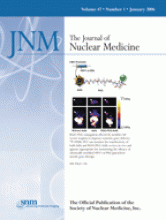Abstract
Three-dimensional (3D) PET acquisition has the potential to reduce image noise but the advantage of 3D PET for studies outside the brain has not been well established. To compare the performance of 2-dimensional (2D) and 3D acquisition for whole-body 18F-FDG applications, a series of patient studies were performed using a lutetium oxyorthosilicate (LSO)-based tomograph. Methods: Comparative 2D and 3D images were acquired for 27 oncology patients using an LSO-based tomograph. Data acquisition (350–650 keV, 6 ns) started 99 ± 12 min (mean ± SD) after injection of 624 ± 76 MBq 18F-FDG. Bias caused by tracer redistribution and decay was eliminated by acquiring dynamic data over a single-bed position using a protocol that alternated between septa-in and septa-out modes (2D, 3D, 2D, 3D, 2D, 3D). Frames were combined to form 8 statistically independent sinograms: four 2D replicates (105 s) and four 3D replicates (90 s). The different frame durations in 2D and 3D compensated for the different number of overlapping bed positions required for an 85-cm whole-body study. Images were reconstructed with either 2D or fully 3D ordered-subsets expectation maximization (2 iterations and 8 subsets; 2D 6-mm gaussian, 3D 5- and 6-mm gaussian). Image target-to-background ratio was assessed by dividing the lesion maximum by the mean within a neighboring background region. Image noise was assessed by applying background regions of interest to the replicate images and calculating the within-patient coefficient of variation. Results: The difference in target-to-background ratio between the 2D and 3D images, when they were filtered with 6-mm and 5-mm gaussian filters, respectively, was not highly statistically significant (P = 0.16). The mean ratio of 3D to 2D image values was 0.94 with 95% limits of agreement of 0.63–1.41. The within-patient coefficients of variation for the 2D and 3D images were 13% ± 15% and 9% ± 10%, respectively (P = 0.0005). Conclusion: Under conditions of matched target to-to-background ratios, the 3D mode was found to produce images with significantly less variability than the 2D mode. These data provide support for the use of 3D acquisition with LSO detectors to reduce scan times in whole-body 18F-FDG applications.







